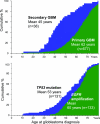Genetic pathways to primary and secondary glioblastoma
- PMID: 17456751
- PMCID: PMC1854940
- DOI: 10.2353/ajpath.2007.070011
Genetic pathways to primary and secondary glioblastoma
Abstract
Glioblastoma is the most frequent and most malignant human brain tumor. The prognosis remains very poor, with most patients dying within 1 year after diagnosis. Primary and secondary glioblastoma constitute distinct disease subtypes, affecting patients of different age and developing through different genetic pathways. The majority of cases (>90%) are primary glioblastomas that develop rapidly de novo, without clinical or histological evidence of a less malignant precursor lesion. They affect mainly the elderly and are genetically characterized by loss of heterozygosity 10q (70% of cases), EGFR amplification (36%), p16(INK4a) deletion (31%), and PTEN mutations (25%). Secondary glioblastomas develop through progression from low-grade diffuse astrocytoma or anaplastic astrocytoma and manifest in younger patients. In the pathway to secondary glioblastoma, TP53 mutations are the most frequent and earliest detectable genetic alteration, already present in 60% of precursor low-grade astrocytomas. The mutation pattern is characterized by frequent G:C-->A:T mutations at CpG sites. During progression to glioblastoma, additional mutations accumulate, including loss of heterozygosity 10q25-qter ( approximately 70%), which is the most frequent genetic alteration in both primary and secondary glioblastomas. Primary and secondary glioblastomas also differ significantly in their pattern of promoter methylation and in expression profiles at RNA and protein levels. This has significant implications, particularly for the development of novel, targeted therapies, as discussed in this review.
Figures



References
-
- Scherer HJ. Cerebral astrocytomas and their derivatives. Am J Cancer. 1940;40:159–198.
-
- Zulch KJ (Ed): Histological typing of tumours of the central nervous system. International Histological Classification of Tumours, vol. 21. Geneva, World Health Organization, 1979
-
- Kleihues P, Burger PC, Scheithauer BW (Eds): Histological typing of tumours of the central nervous system. World Health Organization International Histological Classification of Tumours, ed 2. Berlin, Springer-Verlag, 1993
-
- Ohgaki H, Dessen P, Jourde B, Horstmann S, Nishikawa T, Di Patre PL, Burkhard C, Schuler D, Probst-Hensch NM, Maiorka PC, Baeza N, Pisani P, Yonekawa Y, Yasargil MG, Lutolf UM, Kleihues P. Genetic pathways to glioblastoma: a population-based study. Cancer Res. 2004;64:6892–6899. - PubMed
Publication types
MeSH terms
Substances
LinkOut - more resources
Full Text Sources
Other Literature Sources
Medical
Research Materials
Miscellaneous

